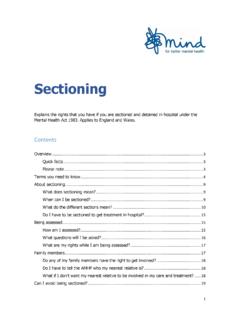Transcription of Resource 3 How to promote webllenig and tacke tl he ... - Mind
1 Resource 3 How to promote wellbeing and tackle the causes of work-related mental health problems 3: How to promote wellbeing and tackle the causes of work-related mental health problems260 per cent of employees say they d feel more motivated and more likely to recommend their organisation as a good place to work if their employer took action to support mental all have mental health just as we have physical health - it moves up and down along a spectrum from good to poor. And considering how much time we spend at work, it s not surprising that workplace environments and culture affect our employers know that organisations perform better when staff are healthy, motivated and focused.
2 Research consistently shows that when employees feel their work is meaningful and they are valued and supported, they tend to have higher wellbeing levels, be more committed to the organisation s goals and, importantly, they perform better too. This strong relationship between levels of staff wellbeing and motivation and business performance is often called employee engagement . FTSE 100 companies that prioritise employee engagement and wellbeing outperform the rest of the FTSE 100 by 10 per By supporting staff wellbeing, they reap the benefits through enhanced morale, loyalty, commitment, innovation, productivity and profitability.
3 Open and supportive workplaces benefit everyone employees, employers and the bottom is not providing legal advice but practical guidance employers may also need to obtain their own legal advice on the approach to take in any particular has developed a three-pronged approach to help employers manage mental health in the workplace by:1. p romoting wellbeing for all staff2. tackling the causes of work-related mental health problems3. supporting staff who are experiencing mental health guide focuses on the first two. It sets out simple, practical and inexpensive steps that any organisation can take.
4 In the first section we look at how adjustments to an organisation s culture can boost employee wellbeing and engagement. In the second we look at steps that line managers and HR teams can take to tackle the causes of mental health problems. 1 Populus poll for Mind of 2,060 adults in England and Wales in employment - polled between 6 and 10 March 20132 BITC Workwell FTSE 100 Public Reporting Benchmarking Research Findings, Business in the Community and Towers Watson, London, April 2013, retrieved from senior leaders on boardEmployers should send a clear message that staff wellbeing matters.
5 Colleagues take cues from how leaders behave. When the CEO speaks out about mental health it can have a huge impact. Leaders can also show the organisation s commitment to staff wellbeing by simple actions such as supporting a campaign to encourage all staff to take lunch breaks and to work healthy you need help making the case to prioritise mental health, our first guide in this series, Introduction to mentally healthy workplaces, clarifies the close relationship between wellbeing, motivation and performance, and breaks down the cost of not acting. Raising awareness of mental health and wellbeingIn many workplaces mental health is the elephant in the room.
6 Too often, employees are scared to talk to their manager and problems can spiral3. Employers need to raise awareness and promote discussion of mental health and wellbeing to proactively challenge this harmful culture. Embed mental health in induction and training Ensure staff are given information on how mental health is managed and what support is available as part of induction. Equality and diversity training should also cover mental health; for example, with a scenario exercise to challenge myths and prejudice. Raise the profile Invite a speaker on mental health to an event as part of activities for diversity, disability or mental health awareness.
7 We can help you with this just email Hearing what it s like to have a mental health problem from people who ve experienced the issues first hand can help break down negative stereotypes. Make the most of internal communications channels Raise awareness through blogs, myth-busters, factsheets, tips for managers, useful web links and FAQs. You can also use posters, noticeboards, staff newsletters, magazines, intranet and internet pages to get the message out. Encourage mental health champions People at all levels talking openly about mental health sends a clear message that you will get support if you re experiencing a mental health problem and that this is not a barrier to career development.
8 Make a statement Sign the Time to Change pledge to make a public commitment to tackle mental health stigma and discrimination. This will send a powerful message that it s OK to talk about mental health. 1. Promoting wellbeingResource 3: How to promote wellbeing and tackle the causes of work-related mental health problems3In this section we ll look at how adjustments to an organisation s culture can boost employee wellbeing and A Populus poll for Mind of 2,060 adults in England and Wales in employment (polled between 6 and 10 March 2013) found that, while stress has forced one in five workers to call in sick, 90 per cent say they lied to their boss about the real reason for not turning up.
9 The survey also revealed that less than half of people with a diagnosed mental health problem had told their boss. Resource 3: How to promote wellbeing and tackle the causes of work-related mental health problems4 Involving staff in dialogue and decision-makingEmployee engagement and wellbeing are interdependent our guide Introduction to mentally healthy workplaces looks at this relationship in detail. When staff feel involved and well informed about what s happening in the organisation, it increases motivation and helps people understand how their role fits into the bigger picture.
10 You should be as open as possible about strategic vision and direction and try to involve all staff in decision-making not only about how they do their job but also about the strategic direction of the organisational changes, such as cost-saving and efficiency measures, new work content and technology, in a way that involves and listens to staff, and take positive action to address any issues identified. When employees are involved in finding solutions they feel ownership of the final decision and morale and productivity levels are less likely to be affected. How to promote dialogue, feedback and engagement staff surveys and focus groups staff forums and diversity networks engagement steering groups monthly or quarterly performance review meetings improvement or planning away days regular group problem-solving meetings or innovation events work-stream groups that bring together different parts of the organisation feeding back board decisions to all staff effectively using internal communication 3.















